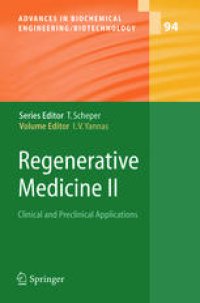
Ebook: Regenerative Medicine II: Clinical and Preclinical Applications
- Tags: Biotechnology, Medicinal Chemistry, Medical Microbiology
- Series: Advances in Biochemical Engineering 94
- Year: 2005
- Publisher: Springer-Verlag Berlin Heidelberg
- Edition: 1
- Language: English
- pdf
Organ regeneration, once unknown in adult mammals, is at the threshold of maturity as a clinical method for restoration of organ function in humans. Several laboratories around the world are engaged in the development of new tools such as stem cells and biologically active scaffolds. Others are taking fresh looks at well-known clinical problems of replacement of a large variety of organs: Bone, skin, the spinal cord, peripheral nerves, articular cartilage, the conjunctiva, heart valves and urologic organs. Still other investigators are working out the mechanistic pathways of regeneration and the theoretical implications of growing back organs in an adult. The time has come to present a collection of these efforts from leading practitioners in the field of organ regeneration.
Organ regeneration, once unknown in adult mammals, is at the threshold of maturity as a clinical method for restoration of organ function in humans. Several laboratories around the world are engaged in the development of new tools such as stem cells and biologically active scaffolds. Others are taking fresh looks at well-known clinical problems of replacement of a large variety of organs: Bone, skin, the spinal cord, peripheral nerves, articular cartilage, the conjunctiva, heart valves and urologic organs. Still other investigators are working out the mechanistic pathways of regeneration and the theoretical implications of growing back organs in an adult. The time has come to present a collection of these efforts from leading practitioners in the field of organ regeneration.